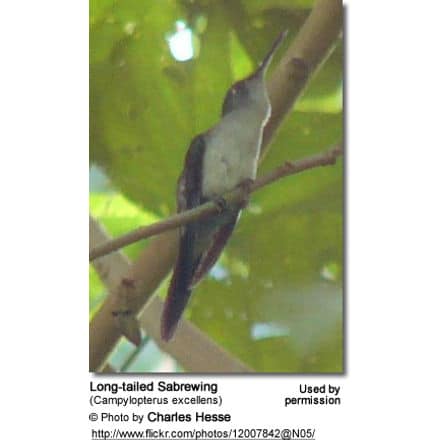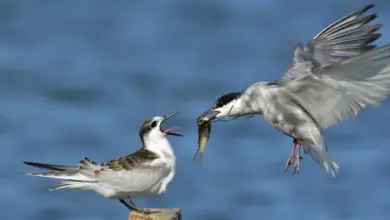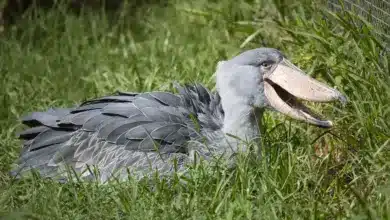Long-tailed Sabrewings
Hummingbird Information
The Long-tailed Sabrewing (Campylopterus excellens) – also known as Tuxtla Sabrewing – is an endangered Mexican hummingbird that is by some authorities considered a subspecies of the Wedge-tailed Sabrewing (Campylopterus curvipennis excellens). However, there are some distinct physical differences between these two species, on which basis they are mostly treated as separate races.
Alternate (Global) Names
Czech: Kolibrík protáhlý, kolib?ík Wetmore?v … Danish: Tuxtlasabelvinge … Dutch: Langstaartsabelvleugel … Finnish: Veracruzinsapelikolibri … French: Campyloptère aztèque, Campyloptère de Wetmore … German: Langschwanz-Degenflügel … Italian: Campilottero codalunga, Sciabolatore codalunga … Norwegian: Langhalesabelvinge … Polish: zapylak dlugosterny, zapylak d?ugosterny … Russian: ????????????? ????????? … Slovak: kolibrík jatagáncek … Spanish: Fandangero Colilargo, Fandanguero Cola Larga … Swedish: Tuxtlasabelvinge
Distribution / Habitat
The Long-tailed Sabrewing occurs naturally around the Isthmus of Tehuantepec in southeastern Mexico. It is fairly common in forests in south-east Veracruz, north-east Oaxaca, and west Chiapas. They are most common in the Sierra de los Tuxtlas in southeast Veracruz, and their alternative name “Tuxta Sabrewing – reflects that. There are records of this species occurring northwest of Tabasco.
It inhabits the interior and borders of humid evergreen forests.
Conservation Status: Its numbers have been declining due to habitat destruction.
Description
The Long-tailed Sabrewing measures 4.7 – 5.1 inches (12 – 14 cm), including the tail. The male weighs between 0.3 – 0.45 oz (9.2 – 12.7 g) and the smaller female between 0.21 – 0.28 oz (5.9 – 8 g). The black, strong bill is slightly down-curved.
The plumage on the back is metallic green and the chest and abdomen range from whitish to pale grey. It has a glossy blue-violet crown and a white spot behind each eye. The long tail is dark green and wedge-shaped.
The Sabrewings are named for their long, saber-like outermost primary flight feathers, which are thickened, flattened, and bent at an angle.
Similar Species
The Long-tailed Sabrewing resembles the Wedge-tailed Sabrewing; except the former is larger in size, the male has a longer tail (hence its common name), and the plumage is paler. Also, the Wedge-tailed Sabrewing can be identified by its distinctive wedge-shaped tail.
Calls / Vocalizations
The song of the Long-tailed Sabrewing includes a complex vocal repertoire that is similar to that of starlings. It is the most complex song of any hummingbird. It consists of more than 200 syllables and is even comparable with the calls of the songbirds.
They rapidly emit chirping, insect-like vocalizations that can go on for several minutes before breaking into a series of excited warbled, or gurgling notes.
Their calls include a persistent, insect-like chipping, squeaks, squeals, and a shrill, nasal peek.
Their songs are usually heard from dense vegetation. Males sing year-round, sometimes in small groups – particularly in the breeding season.
Nesting / Breeding
Hummingbirds in general are solitary and neither live nor migrate in flocks; and there is no pair bond for this species – the male’s only involvement in the reproductive process is the actual mating with the female.
During the breeding seasons, male Sabrewings typically gather in leks (competitive mating display) consisting of up to 10 males (most often 4 to 6). The males will sing to the females to gain their goodwill. They may fly in front of them in a U-shaped pattern.
The male will separate from the female immediately after copulation. One male may mate with several females. In all likelihood, the female will also mate with several males. The males do not participate in choosing the nest location, building the nest, or raising the chicks.
The female Sabrewing constructs the fairly large cup-shaped nest out of plant fibers that are woven together. Green moss is attached to the outside for camouflage. The nest is placed in a protected location on a low, thin horizontal branch of a shrub, bush, or tree – usually situated over a stream. She lines the nest with soft plant fibers, animal hair, and feathers down, and strengthens the structure with spider webbing and other sticky material, giving it an elastic quality to allow it to stretch to double its size as the chicks grow and need more room.
The nest usually has only one single egg, which the female incubates. The young are born blind, immobile, and without any down.
The female alone protects and feeds the chicks with regurgitated food (mostly partially-digested insects since nectar is an insufficient source of protein for the growing chicks). The female pushes the food down the chicks’ throats with her long bill directly into their stomachs.
As is the case with other hummingbird species, the chicks are brooded only the first week or two and left alone even on cooler nights after about 12 days – probably due to the small nest size. The chicks leave the nest when they are about 20 days old.
Diet / Feeding
The Sabrewings primarily feed on nectar taken from a variety of brightly colored, scented small flowers of trees, herbs, shrubs, and epiphytes. They favor heliconia and banana flowers, but may also visit some flowers that open during the night for bats.
They favor flowers with the highest sugar content (often red-colored and tubular-shaped) and seek out, and aggressively protect, those areas containing flowers with high-energy nectar. They use their long, extendible, straw-like tongues to retrieve the nectar while hovering with their tails cocked upward as they are licking at the nectar up to 13 times per second. Sometimes they may be seen hanging on the flower while feeding.
Many native and cultivated plants on whose flowers these birds feed heavily rely on them for pollination. The mostly tubular-shaped flowers exclude most bees and butterflies from feeding on them and, subsequently, from pollinating the plants.
They may also visit local hummingbird feeders for some sugar water, or drink out of bird baths or water fountains where they will either hover and sip water as it runs over the edge; or they will perch on the edge and drink – like all the other birds; however, they only remain still for a short moment.
They also take some small spiders and insects – important sources of protein particularly needed during the breeding season to ensure the proper development of their young. Insects are often caught in flight (hawking); snatched off leaves or branches, or taken from spider webs. A nesting female can capture up to 2,000 insects a day.
Males establish feeding territories, where they aggressively chase away other males as well as large insects – such as bumblebees and hawk moths – that want to feed in their territory. They use aerial flights and intimidating displays to defend their territories.
Metabolism and Survival and Flight Adaptions – Amazing Facts
Species Research by Sibylle Johnson
Please Note: The articles or images on this page are the sole property of the authors or photographers. Please contact them directly with respect to any copyright or licensing questions. Thank you.





